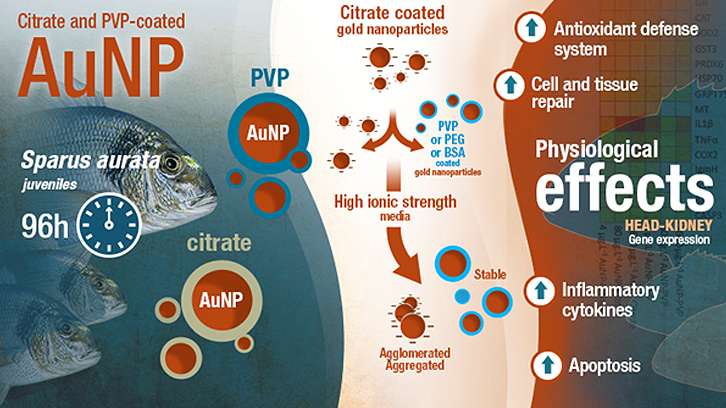Gold nanoparticles can alter fish immune system

Nanoparticles are everywhere. With a range size between 1 and 100 nm, they act as minuscule contraptions that bridge the molecular and cellular information-loaded handshakes. Due to its ubiquitous nature and versatility, data on the potential hazardous effects of the increasingly used engineered nanoparticles is urgently required to ensure human and environmental safety and promote safe use of novel nanotechnologies.
Among the most used nanoparticles, gold nanoparticles (AuNP) have been employed in high technology applications that include drug delivery and recently water remediation and aquaculture practices. One of the prerequisites for its use is their non-toxic and biocompatible nature but little is known in terms of effects of estuarine/marine organisms. An ongoing collaboration between Universitat Autònoma de Barcelona and Aveiro University is studying the behaviour of AuNP under marine conditions and its effects to economically relevant fish species, such as Sparus aurata (gilthead sea bream). This species, widespread in Atlantic and Mediterranean coastal waters, is one of the most commercially important (fishery and aquaculture) and consumed fish in south Europe.
Fig. 1. Left: Cortisol and glucose levels in Sparus aurata plasma after 96 h exposure to gold nanoparticles. Right: gene expression profile as indicated by mRNA transcripts. Highly overexpressed genes are represented with shades of orange/red. AuNP elicit changes in several immune- (il1ß, interleukin 1 ß; cox2, cyclooxygenase 2; igmh, immunoglobulin M heavy chain; tcbr, T cell receptor beta chain; bax, Bcl-2 associated X protein), oxidative- (gpx1, gpx4, glutathione peroxidase 1 and 4; gr, glutathione reductase; cat, catalase; sod2, superoxide dismutase [Mn]; gst3, glutathione-S-transferase 3; prdx6, peroxiredoxin 6) and cellular stress-related transcripts (hsp70, heat shock protein 70; grp75, glucose-regulated protein, 75 kDa; mt, metallothionein; casp3, caspase 3).
Overall, data revealed that although citrate coated gold nanoparticles tend to aggregate in high ionic strength media, some molecules (e.g. polyvinylpyrrolidone, polyethylene glycol, bovine serum albumin) may provide them with stability that allow AuNP to remain in suspension, in the nm size range. Dissolved AuNP seem able to activate the fish hypothalamus-pituitary-interrenal (HPI) axis, the main neuro-endocrine stress regulator in vertebrates, increasing plasma cortisol levels (Fig. 1, left) and potentially disrupting the endocrine responses in fish. Perhaps most worrying of all was the discovery that 96 hours of exposition to AuNP, even with biocompatible coatings and at low concentrations, can alter the expression genes related to antioxidant reactivity, immune responses and apoptosis/cell death processes (Fig. 1, right) in sea bream. This represents a potential impact to marine fish at both the cellular and systemic/whole organism levels.
Further studies are being performed under different conditions to evaluate AuNP impact in the environment and aquaculture facilities to provide information for the safe use of nanoparticles.
mteles0@gmail.com
Department of Cellular Biology, Physiology and Immunology
Universitat Autònoma de Barcelona
References
Teles M, Soares AM, Tort L, Guimarães L, Oliveira M. Linking cortisol response with gene expression in fish exposed to gold nanoparticles. Sci Total Environ. 2017 Apr 15;584-585:1004-1011. doi: 10.1016/j.scitotenv.2017.01.153

